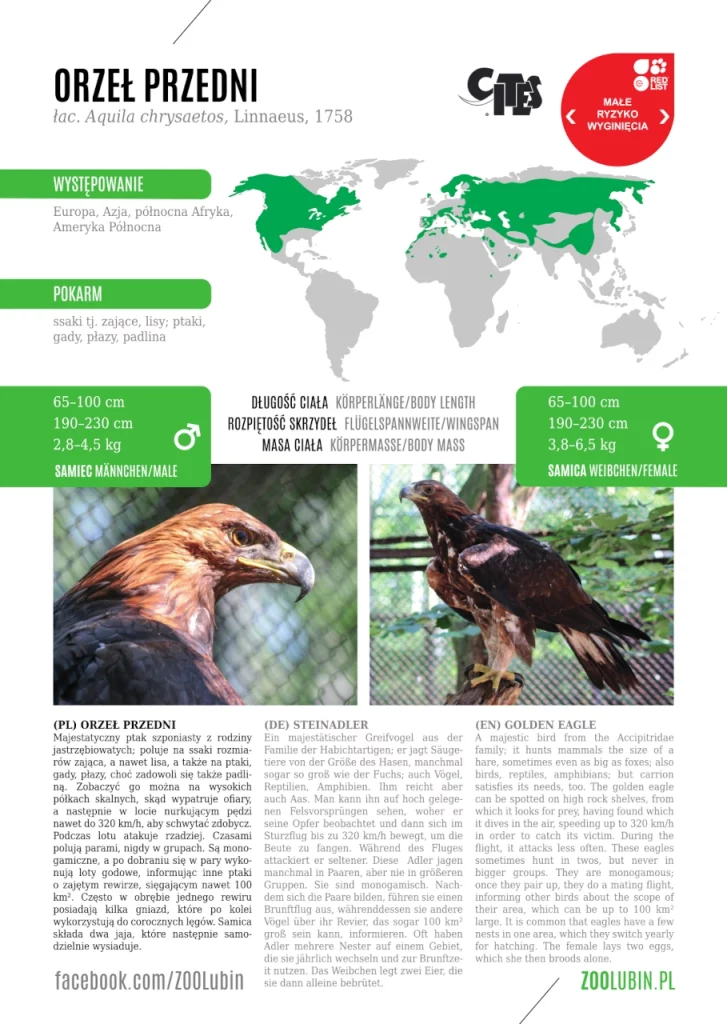
POBIERZ ETYKIETĘ GATUNKOWĄ – PLIK PDF (rozmiar 2254 KB)
Orzeł przedni (PL)
łac. Aquila chrysaetos, Linnaeus, 1758
Majestatyczny ptak szponiasty z rodziny jastrzębiowatych; poluje na ssaki rozmiarów zająca,
a nawet lisa, a także na ptaki, gady, płazy, choć zadowoli się także padliną. Zobaczyć go można na wysokich półkach skalnych, skąd wypatruje ofiary, a następnie w locie nurkującym pędzi nawet do 320 km/h, aby schwytać zdobycz. Podczas lotu atakuje rzadziej. Czasami polują parami, nigdy w grupach. Są monogamiczne, a po dobraniu się w pary wykonują loty godowe, informując inne ptaki o zajętym rewirze, sięgającym nawet 100 km². Często w obrębie jednego rewiru posiadają kilka gniazd, które po kolei wykorzystują do corocznych lęgów. Samica składa dwa jaja, które następnie samodzielnie wysiaduje.
Występowanie: Europa, Azja, północna Afryka, Ameryka Północna
samiec / samica
Długość ciała: 65–100 cm
Rozpiętość skrzydeł: 150–240 cm
Masa ciała: 2,8–4,5 kg / 3,8–6,7 kg
Steinadler (DE)
łac. Aquila chrysaetos, Linnaeus, 1758
Ein majestätischer Greifvogel aus der Familie der Habichtartigen; er jagt Säugetiere von der Größe des Hasen, manchmal sogar so groß wie der Fuchs; auch Vögel, Reptilien, Amphibien. Ihm reicht aber auch Aas. Man kann ihn auf hoch gelegenen Felsvorsprüngen sehen, woher er seine Opfer beobachtet und dann sich im Sturzflug bis zu 320 km/h bewegt, um die Beute zu fangen. Während des Fluges attackiert er seltener. Diese Adler jagen manchmal in Paaren, aber nie in größeren Gruppen. Sie sind monogamisch. Nachdem sich die Paare bilden, führen sie einen Brunftflug aus, währenddessen sie andere Vögel über ihr Revier, das sogar 100 km² groß sein kann, informieren. Oft haben Adler mehrere Nester auf einem Gebiet, die sie jährlich wechseln und zur Brunftzeit nutzen. Das Weibchen legt zwei Eier, die sie dann alleine bebrütet.
Vorkommen: Europa, Asien, Nordafrika, Nordamerika
Männchen / Weibchen
Körperlänge: 65–100 cm
Flügelspannweite: 150–240 cm
Körpermasse: 2,8–4,5 kg / 3,8–6,7 kg
Golden eagle (EN)
łac. Aquila chrysaetos, Linnaeus, 1758
A majestic bird from the Accipitridae family; it hunts mammals the size of a hare, sometimes even as big as foxes; also birds, reptiles, amphibians; but carrion satisfies its needs, too. The golden eagle can be spotted on high rock shelves, from which it looks for prey, having found which it dives in the air, speeding up to 320 km/h in order to catch its victim. During the flight, it attacks less often. These eagles sometimes hunt in twos, but never in bigger groups. They are monogamous; once they pair up, they do a mating flight, informing other birds about the scope of their area, which can be up to 100 km² large. It is common that eagles have a few nests in one area, which they switch yearly for hatching. The female lays two eggs, which she then broods alone.
Distribution: Europe, Asia, North Africa, North America
male / female
body length: 65–100 cm
wingspan: 150–240 cm
body mass: 2,8–4,5 kg / 3,8–6,7 kg
